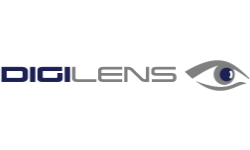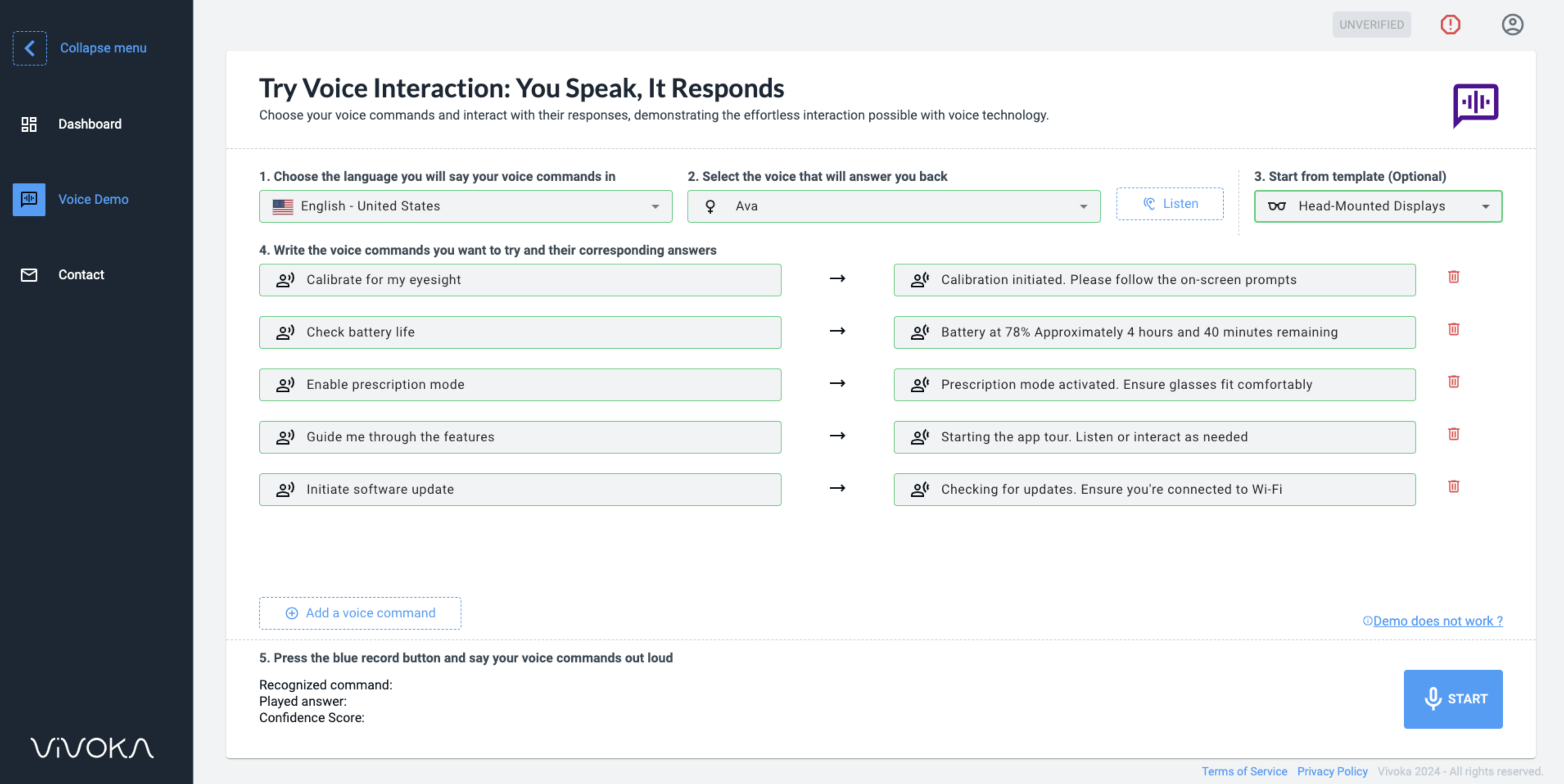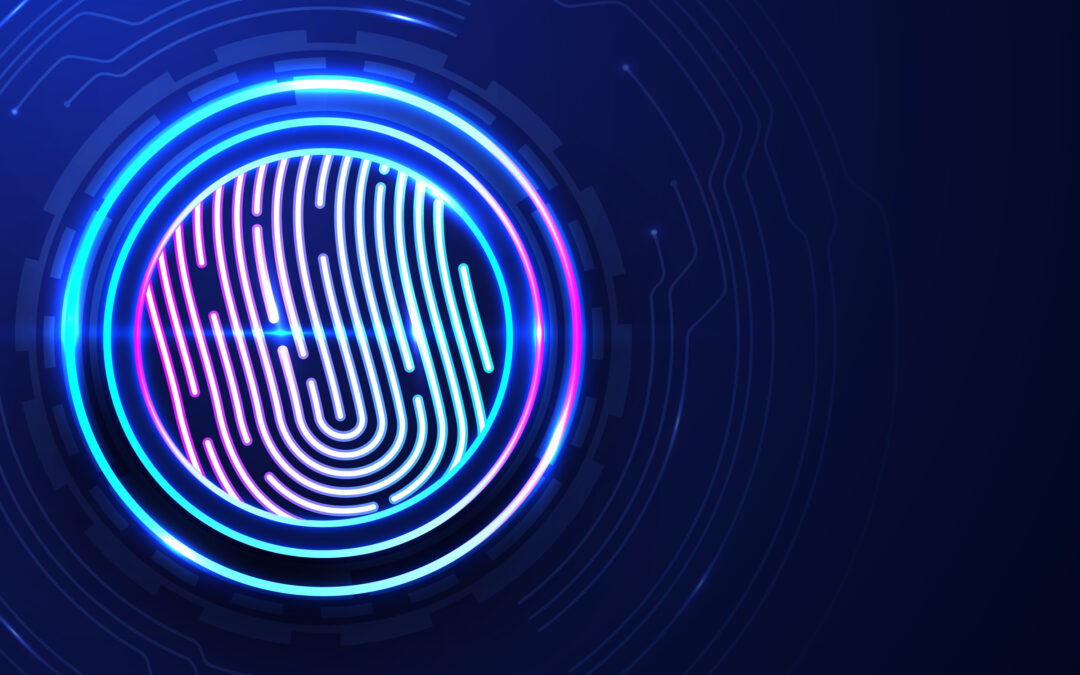Voice for Smart Glasses and XR Wearables
On-device voice technologies to empower XR devices, from Smart Glasses or VR Headsets to any Head-Mounted Displays (HMD) with hands-free control, enhanced safety and service reliability.






Made for wearables
Hands-free interactions thanks to embedded voice AI
The major asset that voice is bringing to XR devices is the ability to interact with them hands-free. In most industrial use cases that we are covering, this is mandatory. Indeed, users have to be able to use equipment at all times, with the minimum safety level that is required.
From the easiest voice navigation features, to the complete voice dictation system, we got you covered.
Available Features
How to turn XR Wearables into voice-enabled devices?
Voice Commands
Ability to completely control the device hands-free.
The technology also allows Dynamic Content Consumer to add flexibility in the amount of recognized voice commands and intents.
Voice Dictation
Text transcription and content spelling (letters/digits…).
Produce long messages, intervention reports or comments as well as spelling a serial key or a licence plate for instance.
Voice Instructions
Life-like voices to carry out instructions to the device’s user.
Hands-free interactions supported by speech synthesis on the device to provide with directions, instructions, reminders…
Microphone Enhancement
Fine-tuning your microphone’s voice recording quality.
Audio Front-End allows to evaluate the recording quality in specific environments (factories, airports…) and apply correcting filters.
Our solutions revolutionize voice control as the preferred method of interacting with machines because all technologies have been designed to seamlessly integrate into the operator’s or doctor’s everyday life. Our advanced voice technologies allow devices to be as compact as possible, eliminating the need for large screens or buttons. This makes the devices convenient and practical, enabling users to maintain a clear view of their surroundings and wear them comfortably.
Moreover, even in challenging environments, our technology performs at its best. With our Speech Enhancement feature, background noise does not interfere with commands. The device processes commands despite any unpleasant noise, transforming them into loud and clear audio instructions. This significantly reduces the error rate.
For developers, by developers
Try our voice technologies now
1
Sign up first on the Console
Before integrating with VDK, test our online playground: Vivoka Console.
2
Develop and test your use cases
Design, create and try all of your features.
3
Submit your project
Share your project and talk about it with our expert for real integration.

Resources
Learn more about Voice and Smart Glasses
Bringing edge voice capabilities to connected AR Smart Glasses
We gathered AR Smart Glasses experts to discuss with our team about the close relationship between voice and vision technologies. We mashed the whole conversation inside a 30 minute long webinar that offers condensed insights, information and data provided by industry specialists.
Smart glasses miss a voice to rise even more
Smart glasses, on the verge of being adopted by the mass, are still lacking something to make it. As AR and wearables enthusiasts, we deliver our insights.
How voice enhances vision-based wearables?
Head-mounted wearables can’t be used like traditional computers and devices. Voice and Vision need to work together in this objective. Here’s how.
Wearing smart glasses is not a burden, the device is designed to be an extension of people. This results in a seamless collaboration between human and technology. Our customers, Vuzix, Rokid, Almer, thought about that while building their glasses.
Smart glasses in our expertise domains

Voice Technologies in Smart Warehouses with smart glasses
Enhance warehouse efficiency with smart glasses integrated with voice technology. These advanced devices allow workers to receive real-time verbal instructions while keeping their hands free, streamlining tasks such as order picking, inventory management, and quality checks. The combination of augmented reality displays and voice commands boosts accuracy, reduces errors, and accelerates training. Smart glasses also provide workers with immediate access to critical data, improving decision-making and overall productivity.
Upgrade your warehouse operations with this cutting-edge technology for a more efficient and error-free workflow.
Transforming Healthcare with Voice Technology with smart glasses
Enhance healthcare with AI-powered medical devices, voice solutions, and smart glasses. AI algorithms quickly analyze data for accurate diagnostics and personalized treatments. In settings like dental chairs and endoscopy, hands-free voice commands enable healthcare professionals to control devices and access patient information, maintaining sterility. Smart glasses provide real-time data and instructions, further streamlining workflows. During procedures, voice commands adjust camera views or lighting, ensuring uninterrupted focus.
This integration revolutionizes medical workflows with precision, efficiency, and reduced contamination risk.

Features and benefits from the VDK
If you are not already sure that the VDK is made for you

Internet Independent
By embedding our solution, your device doesn't need an Internet connection to run. VDK's technologies are designed to operate without requiring connectivity.

Privacy by Design
Our privacy safeguards at the product, algorithm, and business-model level ensure compliance with the strictest data regulations.

Predictable Costs
Master your budget with a clear pricing supporting your innovation and that adapts to the scalability of your project.

Cross-platform
We adapt to all your use cases with versatility, while being compatible with the largest microprocessor and device manufacturers.

Cloud-like accuracy
Performance and accuracy that meet DeepTech standards, all on the device.

Multilingual Conversations
Technologies inside the VDK understand and respond to you naturally in over 60 languages.
Good morning, Guten Tag, Bonjour, Bom Dia, Buongiorno...
As we already said, language support is not a problem

English

Swedish

Indonesian

Thai

French

Russian

Dutch

Norwegian

Italian

Portuguese

Korean

Polish

German

Arabic

Danish

Ukrainian

Spanish

Hindi

Greek

Turkish

Japanese

Mandarin

Hebrew

Malay
Technical requirements
Key specifications to use the VDK
| Language count | 41 |
| Model + Resource Size | 6 to 15MB |
| SDK Code Size | 10 to 65MB |
| Platform supported |
Windows – x86_64 Linux – x86_64 | armv7hf | armv8 Android 6.0 (API 23) |
| Hardware supported | MPU |
| Language count | 41 |
| Model + Resource Size | 6 to 15MB |
| SDK Code Size | 10 to 65MB |
| Platform supported |
Windows – x86_64 Linux – x86_64 | armv7hf | armv8 Android 6.0 (API 23) |
| Hardware supported | MPU |
| Language count | 5 |
| Model + Resource Size | 30 to 50MB |
| Platform supported |
Windows – x86_64 Linux – x86_64 | armv7hf | armv8 Android 6.0 (API 23) |
| Hardware supported | MPU |
| Language count | 65 |
| Model + Resource Size | <1MB up to 500MB per voice depending on the quality |
| SDK Code Size | 5 to 65MB |
| Platform supported |
Windows – x86_64 Linux – x86_64 | armv7hf | armv8 Android 6.0 (API 23) |
| Hardware supported | MPU |
| Language count | Agnostic |
| Model + Resource Size | <1MB to 20MB |
| SDK Code Size |
<1MB = 50KB / User registered 20MB = 5KB / User registered |
| Platform supported |
Windows – x86_64 Linux – x86_64 | armv7hf | armv8 Android 6.0 (API 23) |
| Hardware supported | MPU |
| Language count | Agnostic |
| Model + Resource Size | None |
| SDK Code Size | 3MB |
| Platform supported |
Windows – x86_64 Linux – x86_64 | armv7hf | armv8 |
| Hardware supported | MPU |
Get started
Complete the form and start your free evauation of the VDK.
In conclusion, integrating our voice technologies with smart glasses and XR wearables revolutionizes hands-free interactions, making devices more intuitive and user-friendly.
By enhancing smart glasses with voice commands, dictation, and microphone enhancement, we provide comprehensive solutions that improve efficiency and productivity in various applications, including warehouse operations and medical environments.
Our commitment to privacy, cross-platform compatibility, and multilingual support ensures that our technologies meet diverse user needs while maintaining high performance. Experience the future of augmented reality and wearable technology with our advanced voice solutions, and see how voice can transform your smart glasses into powerful tools for everyday use.
Our technologies function on multiple brand such as our customers’ ones: EPSON, Vuzix, Rokid and Almer. If you want to integrate voice control on another brand, we will make sure that the integration is seamless, for exemple on HTC or XReal glasses.
Contact us to know more!
Smart glasses for your convenience
Smart Glasses and Prescription Lenses
Modern smart glasses can be fitted with prescription lenses, allowing users to enjoy the benefits of augmented reality without compromising their vision. This integration ensures that users with visual impairments can still take full advantage of the cutting-edge technology in smart glasses. With the addition of prescription lenses, smart glasses become more versatile and accessible to a wider audience.
These glasses could also serve as sunglasses for operators working outdoors, providing both protection from the sun and advanced technological features. The technology must integrate seamlessly into human work, ensuring that the device is a practical and beneficial addition to daily tasks. Just as sunglasses offer comfort and eye protection, augmented reality glasses should facilitate everyday work by enhancing productivity, offering real-time data overlays, and improving communication. By combining the benefits of traditional sunglasses with cutting-edge AR capabilities, these glasses can transform how operators interact with their environment.
Integration with Mobile Devices
Our voice technologies enable smart glasses to pair seamlessly with mobile devices (phone, teblet), enhancing their functionality. This integration allows users to receive notifications, control apps, and access information directly through their smart glasses. By connecting to an external device, our voice solutions provide a comprehensive augmented reality experience, making daily tasks more efficient and hands-free.
It's always the right time to learn more about voice technologies and their applications
When Order Fulfillment Challenges meet Customer Experience
The logistics industry operates in hectic and ever-changing environments in which managing order fulfillment processes effectively is decisive in maintaining a strong relationship with the customer....

Four Ways Technology Helps You Overcome the Labor Shortage in Logistics, TMS, and WMS

Voice AI: The new backbone of Supply Chain problems solving

Wake Words for your industry: why they matter for field services

Voice Biometrics: Why is it relevant for your business?


